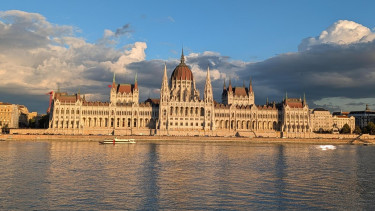COVID-19: Nearly 8,500 new cases, 100 deaths over 24 hours in Hungary


SNAPSHOT --- 9 November 2021 vs. 9 November 2020:
- new cases--- 8,434 vs. 4,140 (+104%)
- active cases--- 78,025 vs. 88,737 (-12%)
- in hospital--- 4,830 vs. 6,153 -(21.5%)
- on ventilator--- 463 vs. 461 (+0.4%)
- test positivity rate --- 28.42% vs. 26.34%
- 3-day average percent positive--- 25.39% vs.23.95%
- 7-day average percent positive--- 21.94% vs. 25.42%
- 21-day average percent positive--- 17.52% vs. 17.78%
- 7-day average of 3-day / 21-day average positivity rate--- 138% vs. 127%
- accumulated cases (1 Aug – 9 Nov) --- 113,413 vs. 114,392 (-0.9%)
- accumulated deaths (1 Aug – 9 Nov) --- 1,592 vs. 1,9998 (-20%)
The exponentially growing number of new cases is already making a significant impact on the health care system. The tables below show how the changes in the number of daily new confirmed COVID-19 cases, hospitalisations and the number of ventilated Covid patients in 2021 and 2020.
In the top chart we compared the figures of 8 November to one, two, three, and four weeks earlier. The bottom chart shows the week-on-week changes. The red cells make it evident that the epidemiological situation has been worsening at a more alarming rate in almost every aspect than in the base period.


The current epidemiological figures eerily resemble that of the ‘second wave’ last autumn, while about 60% of the population are vaccinated against coronavirus. The graphs attest that this is not the ‘wave of the unvaccinated’ as many ‘experts’ projected it would be.






The number of Covid patients admitted to hospitals and needing mechanical ventilation has been on the rise for a while now, and their are already at early-May levels.

On the charts below the 0% line is important. When the curves are under 0% there’s a decline, when they go over 0% it’s an increase. The changes show that the situation in terms of hospitalisations started to worsen after 20 August.
More importantly, when a value is north of 0% but the curve descends, it means an increase at a slowing rate, rather than a decrease. If the curve is above 0% and ascending, it is an increase at an accelerating rate. When we are under 0% and the curve goes lower, it translates into an accelerating decrease, and when it goes up it marks a decelerating decrease.

As you can see, the number of those in hospital and of those on ventilator grow almost fully synchronously, apart from a period between mid-September and end-October. In that period there was not enough room for Covid patients and that is why there were many on ventilator relative to the number of Covid patients hospitalised. Then Covid capacities were added to the system and the 'link' was back the way it was before.
The same can be observed at the charts below, only with ratios. The share of those in hospital to the number of active cases has come down from its peak because daily testing picked up, and while there are more and more people with coronavirus infection in hospital, the number of active cases has been growing at a higher rate. And the ventilated / in hospital ratio has also dropped due to the aforementioned reason.

A couple of graphs about the positivity rate. Not reassuring, either of them, weather they show a longer term or more recent developments.


When the Case Fatality Rate (CFR, shown on a reversed scale below) drops. the pandemic starts to gather momentum, because CFR = deaths / registered cases. There is an increasing number of new confirmed COVID-19 cases but the number of Covid fatalities is just starting to catch up. Whatever looks like a drop on the chart, is actually an increase in reality. On this chart the CFR is shown in parallel with the number of new daily confirmed cases, as well as their 3-day and 7-day averages.
CFR is the number of Covid fatalities divided by the number of confirmed cases. If you perform very few tests as Hungary does, you'll have massive underdetection. The number of deaths rise but the number of confirmed cases remains relatively low, hence the high CFR.

As regards the left-hand chart below, the number of new COVID-19 cases accumulated since 28 August is only 2% lower than in the same period of 2020, while it was 25% lower only two weeks ago and nearly 50% lower six weeks ago. In the meantime, the accumulated time Covid patients spend in hospital is 32% shorter than a year ago, while it was about 22% lower four weeks ago and 8% higher eight weeks ago. (The turnaround came about on 22 September, about a month after the no-restrictions four-day celebrations of the foundation of the state on 20 August.)
On the right-hand chart see that two months ago the number of accumulated days spent in ICUs (practically on ventilator) was more than double of the base period's print (+120%). Since then, the difference has shrunk to only 2.1%, but it has widened in the last few days (from 1.7% last Friday) despite the lower number of cases (accumulated) and fewer days (accumulated) coronavirus patients spend in hospital. This means that there should be a lot more cases to match the severity of this wave as demonstrated by the number of days spent on ventilator.

In terms of the accumulated number of Covid-related fatalities we are not where we were a year ago (accumulation is 21% lower vs. 78% higher 8 weeks ago), but same time last year there were no vaccines and cross-immunity (if it works at all) was assumably not as strong as currently. The right-hand chart also depicts that those that admitted to hospital with coronavirus infection are generally in worse condition than Covid patients a year ago.

The number of Covid patients hospitalised is about 26% of the corresponding figure on the same day in 2020, while the number of those in ICUs is already higher than in the base period (3-day average has been higher for the fourth consecutive day.)


There is no progress in the vaccination campaign. People that have been fully vaccinated in the basic protocol seek third doses, but even that growth rate needs to be higher, while those that have refused to get their shots are not changing their minds en masse despite the worsening epidemiological situation. And there's also the issue of the waning effectiveness of vaccines to consider...
The government made mask-wearing mandatory in public transport and authorised companies to make vaccination compulsory, but that's about as far as new restrictions go. Oh, it also ordered hospitals to put off elective surgeries.
The cabinet also announced a one-week vaccination campaign where people can get their first, second or third jab without prior online registration. What he cannot understand, and what has not been explained by anyone so far, is why the cabinet waits TWO AND A HALF WEEKS for the campaign to start on 22 November.



Cover photo: Getty Images









